A Month Of Trucking With Daniel B.
Topic 6390 | Page 14
12/28 Continued...
Keep in mind there are two types of jackknives - a tractor jackknife and a trailer jackknife.
A trailer jackknife tends to happen when you're empty on slick roads. You hit the brakes, the trailer brakes lock up, and the back end of the trailer starts sliding to the left or right. The tractor often keeps pointing straight ahead and has full traction.
A tractor jackknife tends to happen on slick roads when you're loaded heavy, your tractor and trailer are not quite lined up in a straight line, and you hit the brakes. It can also happen if you hit the gas too hard on slick roads causing the drive tires to break loose. Maybe you're going around a curve. Maybe your trailer tandems are out of alignment a little bit. Anything that makes your tractor point in a slightly different direction than your trailer...and I mean slightly....can cause this. The drive tires on your tractor will lose traction and the rear of your tractor spins around to one side or the other as the weight of the trailer pushes your tractor around. The trailer stays straight ahead and often times does not lose traction. The tractor spins around and slams into the side of the trailer.
Now trailer jackknives tend to happen rather slowly and are normally pretty easy to get out of if you can let off the brakes a little and lightly touch the gas. Once you let off the brakes the trailer tires can begin finding a grip and touching the gas will pull the trailer back in behind you. I've had this happen on slick roads with an empty trailer in strong crosswinds without hitting the brakes. I've also had this happen when hitting the brakes with an empty trailer on slick roads. As soon as you notice that trailer is moving to one side or the other you let off the brake, touch the gas a little, and you're usually fine. Of course if you aren't in a position to be able to let off the brake and touch the gas a little you're in big trouble. Once that trailer loses traction and starts coming around it's not going to stop coming around until you allow it to. Fortunately because the trailer is so long it comes around rather slowly.
A tractor jackknife normally happens so fast that by the time you realize what's happening your tractor is facing the wrong direction on the highway and you get smashed into the side of your own trailer. Because the wheelbase is so short on the tractor it whips around way more quickly than a trailer jackknife. The only time I had this happen in a scary way was when I was climbing a hill on slick roads with a light load and the drive tires broke loose. I heard my engine wind up and suddenly my tractor was on a 45 degree angle toward the snowy field to my right. From the time I was going along quietly until I was facing that field was less than one second. Fortunately the moment I heard the engine rev I knew exactly what it was and instantly let off the gas and started steering left. The entire tractor and trailer went about halfway into the hammer lane, which was empty fortunately, but I saved it and continued on.
Now I'll say this.....having the drive tires break loose like that when you're on the gas like mine did isn't nearly as bad as having them break loose when you're on the brakes. I was able to save a tractor jackknife caused by too much power to the drives on slick roads. But you normally won't be able to save a tractor jackknife caused by over-braking on slick roads because:
1) The trailer is "pushing" the tractor harder if the drive tires break loose when you're on the brakes than it does when you're on the gas so the tractor tends to spin around more quickly if you're under braking.
2) There is a delay in the air brake system that you don't have with hydraulic brakes. Hydraulic brakes react almost instantly. Air brakes react more slowly. So even if you react almost instantly to a tractor jackknife caused by heavy braking that 1/2 of a second or so can mean the difference between saving it or wrecking it.
You never want to be in my position and I feel bad if I had a student because he probably wouldn't have gotten to drive the past 5 days. Always shut down if you feel unsafe. Honestly though, I did feel unsafe. But this is Montana in late-December, these roads are not going to get any better. So its either push through, or sit here for two months. All in all, I did 507 miles today in a 12 hour day. I enjoyed a nice two hour shower to relax myself - and maybe get my hair to start sprouting Brown again. Stress Level: 10/10 today.

Tandems:
Tandem Axles
A set of axles spaced close together, legally defined as more than 40 and less than 96 inches apart by the USDOT. Drivers tend to refer to the tandem axles on their trailer as just "tandems". You might hear a driver say, "I'm 400 pounds overweight on my tandems", referring to his trailer tandems, not his tractor tandems. Tractor tandems are generally just referred to as "drives" which is short for "drive axles".
Tandem:
Tandem Axles
A set of axles spaced close together, legally defined as more than 40 and less than 96 inches apart by the USDOT. Drivers tend to refer to the tandem axles on their trailer as just "tandems". You might hear a driver say, "I'm 400 pounds overweight on my tandems", referring to his trailer tandems, not his tractor tandems. Tractor tandems are generally just referred to as "drives" which is short for "drive axles".
OOS:
When a violation by either a driver or company is confirmed, an out-of-service order removes either the driver or the vehicle from the roadway until the violation is corrected.

Wow. Just.. wow. Daniel I am glad you made it through today safely. I hate the winter and I hate catch 22's. Having no choice but to drive in conditions like you experienced today are by far my #1 worry when it comes to choosing this as a career. Sort of speechless right now. I'm going to go back to studying the High Road Training Program and think happy thoughts. Just wanted to say thanks again for what you do here and glad you're alright.

CDL:
Commercial Driver's License (CDL)
A CDL is required to drive any of the following vehicles:
- Any combination of vehicles with a gross combined weight rating (GCWR) of 26,001 or more pounds, providing the gross vehicle weight rating (GVWR) of the vehicle being towed is in excess of 10,000 pounds.
- Any single vehicle with a GVWR of 26,001 or more pounds, or any such vehicle towing another not in excess of 10,000 pounds.
- Any vehicle, regardless of size, designed to transport 16 or more persons, including the driver.
- Any vehicle required by federal regulations to be placarded while transporting hazardous materials.
OOS:
When a violation by either a driver or company is confirmed, an out-of-service order removes either the driver or the vehicle from the roadway until the violation is corrected.
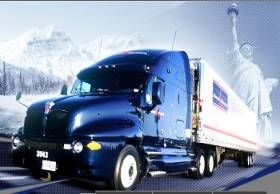
Uh, yep wish I hadn't read that. Eek! Stay safe.

<
Folks, this is exactly how it goes if you do it right. They give you a tough load, you don't complain and just do it and do it perfectly. They give you a shorter run, and as repayment they give you a sweet load like this one. This load wasn't given to me for no reason, I earned it. You work hard, have a great attitude, make all your appointments on time - and you'll be treated like gold.
After I celebrate receiving this load, I take off!
Sorry if I missed an important point but.....why are we celebrating? What is so special about a load of potatoes? Was it the timing of the pickup? What?
My wife says grey hair is wisdom that you have learned... =D

Excellent post Daniel B. Truly enjoying reading it. You ought to write a book. Stay safe and have a Happy New Year!
Meper
<
Folks, this is exactly how it goes if you do it right. They give you a tough load, you don't complain and just do it and do it perfectly. They give you a shorter run, and as repayment they give you a sweet load like this one. This load wasn't given to me for no reason, I earned it. You work hard, have a great attitude, make all your appointments on time - and you'll be treated like gold.
After I celebrate receiving this load, I take off!
Sorry if I missed an important point but.....why are we celebrating? What is so special about a load of potatoes? Was it the timing of the pickup? What?
It's not about the freight, it's all about the miles. As a driver who hails everything Prime has to offer, I don't care about what I'm hauling.
I get paid the same rate hauling a deadly Corrosive chemical versus hauling cupcakes.
The celebration was because I got that nice load. I endured what they had for me and I came out on top with this load. Great loads are harder to come by, you usually have to do a favor first. For example, I'll do a short 350 mile load for them then they'll toss me a bone and give me a 1,000+ mile load. And my celebration usually consists of a few cheers, a dance if I'm energetic, and a nice cup of tea.
12/29
My prayer for today:
Less ice, more dry roads.
Yesterday was a really bad day. I am hoping that today will be better. I sat down and trip planned everything out again and it turns out I'm still on schedule but more behind than ahead. My plan is to get as close as I can and drive early morning on my delivery day. I should make it, unless something unforeseeable happens.
Remember my A, B, C's? Here it is:
Plan A: Park at a facility 10 miles from my delivery.
Plan B: Park at the TA in East Seattle.
Plan C: Park at the nearest Truck Stop/ Rest Area before Seattle.
I start my day at 0730. Before I drive I drain my air tanks. Air storage tanks are used to hold compressed air. The number and size of air tanks vary among vehicles. The tanks will hold enough air to allow the brakes to be used several times even if the compressor stops working. Compressed air usually has some water and compressor oil in it, which is bad for the air brake system. For example, the water can freeze in cold weather and cause brake failure. The water and oil tend to collect in the bottom of the air tank. Be sure to drain the air tanks completely. Each air tank is equipped with a drain valve in the bottom. Draining your air tanks should be done daily.
You need to find the location of the air tanks and pull the drain valve, you will hear air hiss out of the tank. If you notice water in the tank, keep draining the tank till all of the water is out of the tank. Your goal is to have dry air going through those air lines.
It's very important to not be lazy about draining them. Moisture builds up and you need to make sure you have as dry air as possible.
Here is the drain valve. Turning this releases the air from the air tank. That nozzle I'm pointing at is the drain valve. As you can see the tank is on the left with a bunch of hoses coming out of it. If you look to the right you'll see my brake chambers. This should give you an idea of where it can be.

Also, remember my picture of the back of my trailer from yesterday? Be sure you clean those lights, reflective tape, and license plate off before you drive. This could be a ticket. So before I left, I made damn sure I was fully ready to go. While wiping my reflective tape, I was greeted by two large friendly dogs and I took about 10 minutes petting them.
Ya know, it felt really special being greeted like that by those dogs. The fact is, and I hope I don't sound like a complete loser, we get treated like dirt out on the road. Our customers care so little about us that some of them don't even supply us with a restroom. Other motorists just pass us and cut us off rudely. Eventually, you sort of succumb to this feeling of being invisible to the world. You never see friends, and everyone you do see treats you like scum. I can honestly say, this is the first time I actually felt welcomed in weeks. Even though it was just a bunch of dogs, at least something/someone saw me and greeted me.
The roads were iced until I got to Idaho. It wasn't anything too bad and Montana DOT did a great job with the roads today. I did have a few more 6% downgrades but there was enough grip on the road to not struggle too much with them.
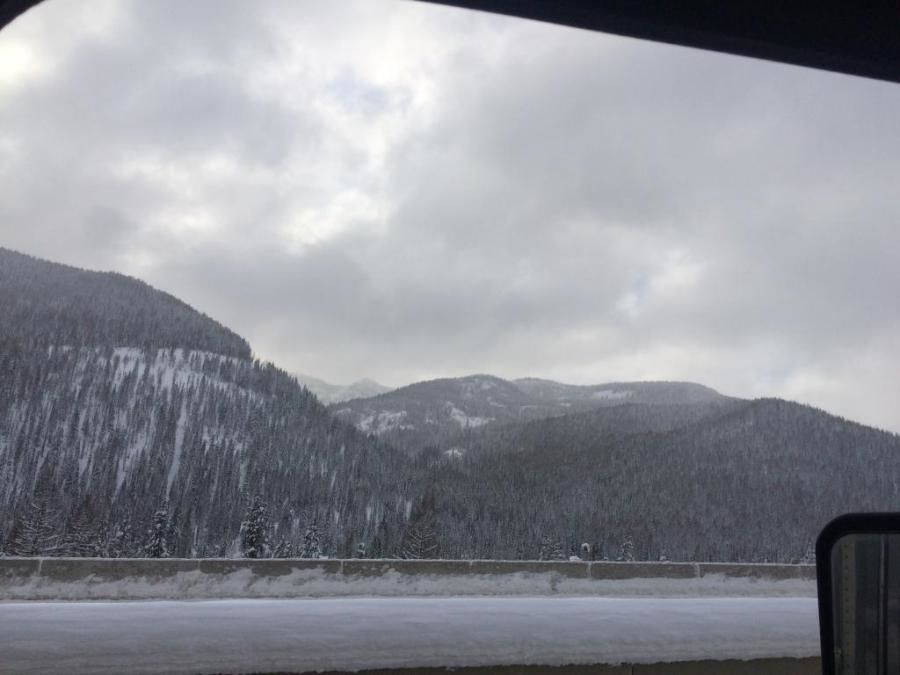
So, Plan A is out of the picture because I don't have enough time to get to Seattle today.
I decided against Plan B because I don't think there will be parking at 1900. That TA isn't very big and fills up quickly. So Plan C is todays gameplan. I found a small truck stop/dirt lot 92 miles from my destination and that's where I parked. There was a rest area in Cle Elum but why drive 10 miles more when I have a guaranteed spot here?
So here's my final trip planning. I will get my hours back at 0400 tomorrow and do a quick Pre-Trip Inspection and take off immediately. I am planning to get there 15 minutes before my appointment time. A little too close, but on time is on time.
There's a lot of annoyance factors in the North. Like struggling to clean your mirrors because the second liquid goes on the mirrors the liquid freezes, and constantly having to clean your wiper blades because they accumulate snow and ice blocks build up. Also, driving through St. Paul gave me a flashback of the time I almost got into an accident there and caught it all on camera.
Daniel B.'s Wild Near Accident!
Pre-trip Inspection:
A pre-trip inspection is a thorough inspection of the truck completed before driving for the first time each day.
Federal and state laws require that drivers inspect their vehicles. Federal and state inspectors also may inspect your vehicles. If they judge a vehicle to be unsafe, they will put it “out of service” until it is repaired.
DOT:
Department Of Transportation
A department of the federal executive branch responsible for the national highways and for railroad and airline safety. It also manages Amtrak, the national railroad system, and the Coast Guard.
State and Federal DOT Officers are responsible for commercial vehicle enforcement. "The truck police" you could call them.
HOS:
Hours Of Service
HOS refers to the logbook hours of service regulations.12/29 Continued...
Why have I been starting my days at 0700-0800 lately? Montana is a dangerous place in the daylight, and even more dangerous when the sun is gone. The chance of black ice is too great so I started driving when the visibility improved for safety reasons.
I did 530 miles today, a much better day than yesterday. I stopped by my favorite truck stop St. Regis Travel Center for a 30 minute break. I bought two presents for my wife. I wanted this shirt but decided against it.

Today was great. Yes, there was bad road conditions for a few hours but the positive outweighed the negative today. My paycheck last week was 619$ take home, not great but not bad for a 1500 mile week. I was a paid tourist. Don't believe me? Then take this!

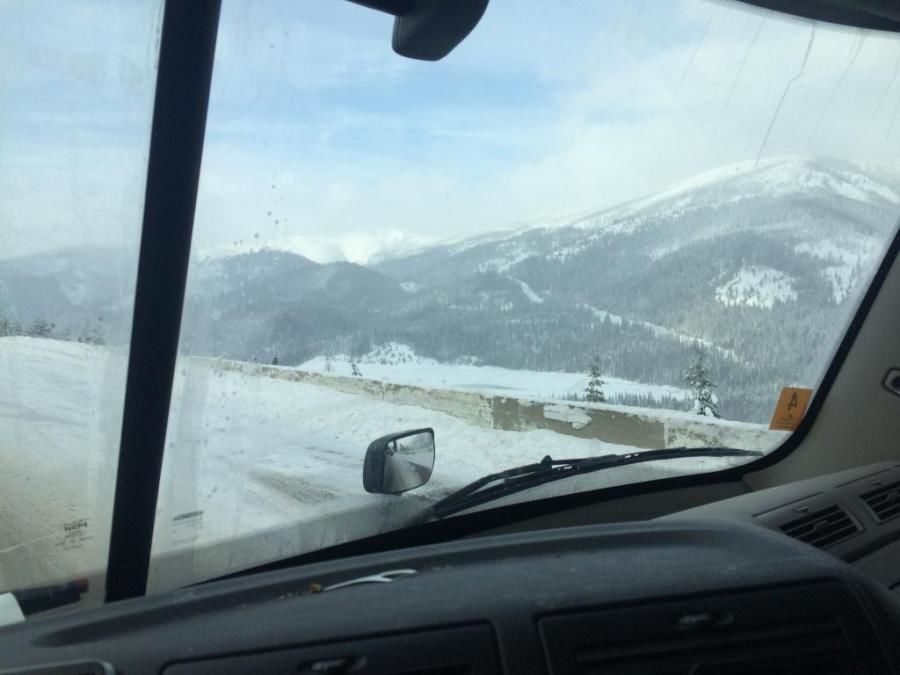
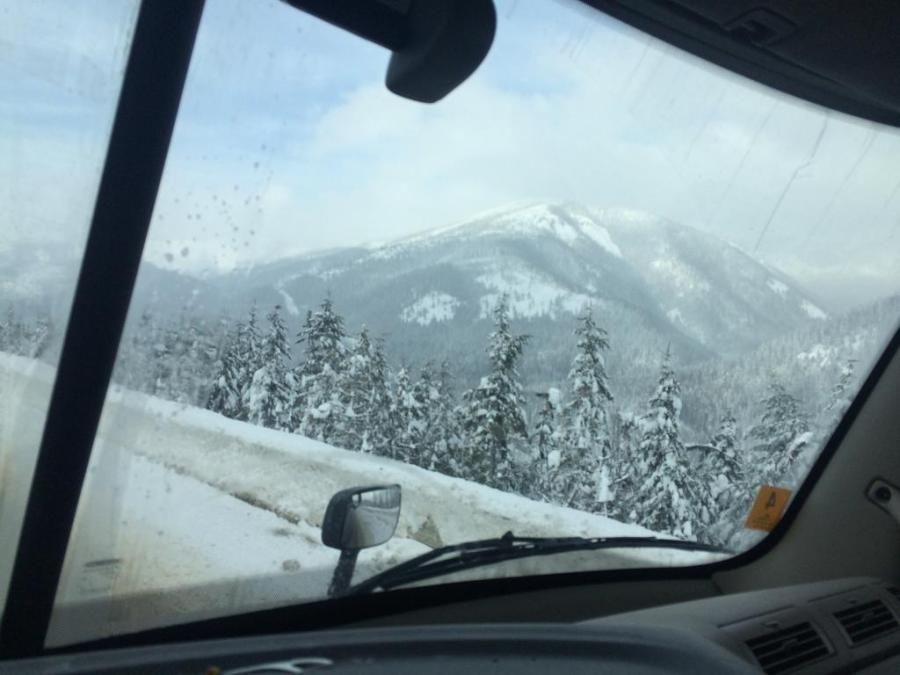
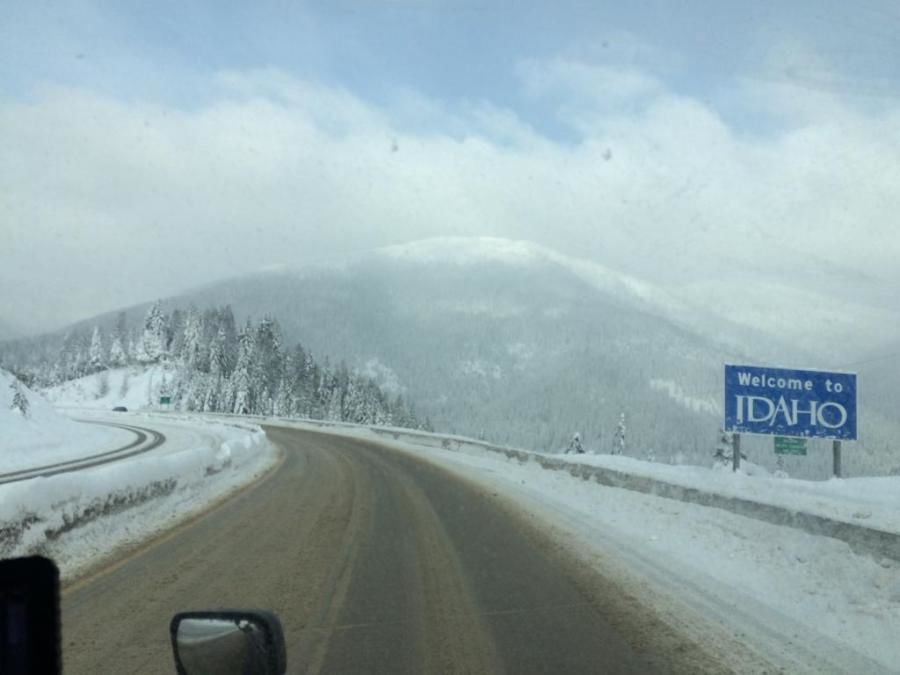
New Reply:
New! Check out our help videos for a better understanding of our forum features

















Preview:
This topic has the following tags:
Advice For New Truck Drivers Cooking In The Truck Food & Eating On The Road GPS Systems Home Time Life On The Road Logbook Questions Time Management Trip Planning Truck Driving Lifestyle Truck Driving Stories Trucker's Family Matters Winter Driving Tips







 TT On Facebook
TT On Facebook
12/28
Today I only have 9.5 hours to work so not a super long day. I woke up this morning and I was under the impression that this would be my relaxing day. The truck looked ready, and I looked ready - apart from a couple of grey hairs.
I started driving at 0700 this morning, just trying to stay ahead of schedule. Well, this "relaxation" day turned out to be one of the worst days I've had in my entire trucking life. The weather was constantly at my back and I was constantly holding onto the wheel with my life depended on it. I had to go down two 6% downgrades on a completely iced covered road. You want tips? Just pray that you won't lose traction.
I took them in 6th gear and I established 15mph as my Safe Speed. Everytime I reached 15mph I used my brake slowly and gently until I lowered myself down to 10mph. Then I would let off the brake and repeat once my speed got back up to 20mph. Consider that I'm going extremely slow and the temperature outside. Your brakes heat up a million times faster at 60mph versus 15mph. Also, it was about 3 degrees outside not including the windchill. So while you're driving, ice cold air is hitting those brakes and cooling them down quickly. The one thing you don't want to do is hold your brakes. But overheating your brakes is much less of a concern in my situation.
How do I know when my brakes are fading (overheating)? The pedal will begin to feel like a sponge. It will sink to the floor faster and have less braking power. Trust me, you'll immediately know it.
Obviously you want to try to time when you use your brakes. For example, avoid using them on bridges because they're usually nothing but a sheet of ice. Also avoid using them when going on curves, or else you might find your trailer trying to overtake you causing a jackknife. Another thing, as much as you want to, do not use those jake brakes. Man, I can assure you that if I used my jake brakes I would be a goner. This is the driving conditions I faced.
Using the foot brake applies braking pressure to all axles on the vehicle, starting with the trailer axles first. The foot brake begins to slow the trailer just a bit before you begin slowing the tractor to help prevent a jackknife. It also puts just a tiny bit more pressure on the trailer axles than the tractor axles for the same reason.
When you apply the Jake Brakes at any level you're only applying braking force to the tractor drive axle(s). It could be one axle, it could be both, depending upon whether or not you have the axles locked together. But regardless, the Jake only applies braking pressure to the drive axles which makes the vehicle more prone to jackknifing.
Now I have to say for safety's sake that you are taught never to use your Jakes at all on slick roads and that's what I'm going to recommend you do. However, let's say hypothetically that someone was holding a gun to your head during a snowstorm and said, "Use your Jakes or I'll shoot." In that case, make sure you use the foot brake along with the Jakes and make sure you never have the Jake Brake on without the foot brake being used. Apply some pressure with the foot brake and then consider kicking your Jakes on at a low setting. When you're going to let off the brakes turn off the Jake Brake first and then let your foot off the foot brake. That way you won't get shot in the head, nor will you jackknife (hopefully).
HOS:
Hours Of Service
HOS refers to the logbook hours of service regulations.OWI:
Operating While Intoxicated